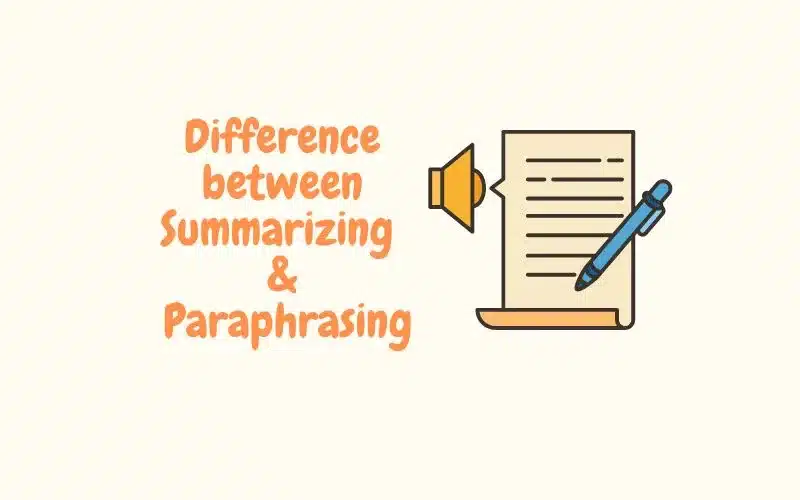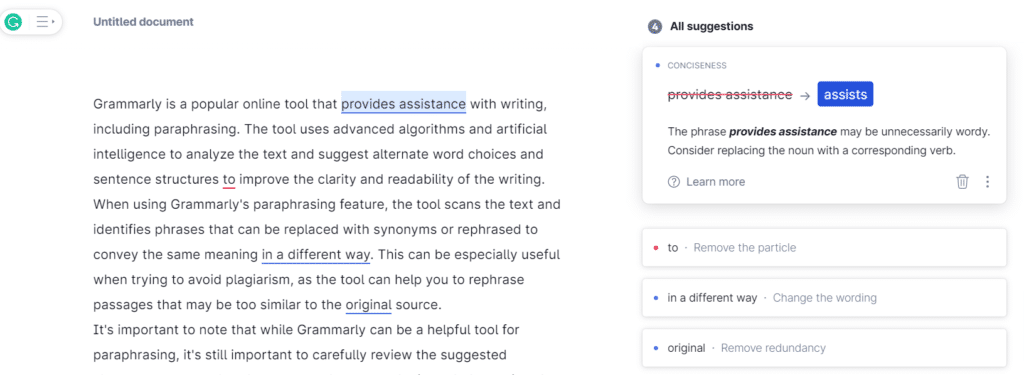In academic and professional settings, the skills of summarizing and paraphrasing are essential because they enable you to effectively convey the thoughts of others without simply copying and pasting their words.
The ability to accurately and effectively summarize or paraphrase is essential when writing a research paper, business proposal, or news article.
Table of Contents
What is the Difference Between Summarizing and Paraphrasing?
Paraphrasing and summarizing are both ways to rephrase a piece of writing in your own words, but their approach and purpose are different.
Summarizing
Summarizing is the process of shortening a big amount of information into shorter parts by only including the most important parts. It’s like giving a summary of a long book or movie to someone else, but only mentioning the key points and leaving out all the details.
Summarizing helps us understand information better by focusing on what’s most important. Summarizing gives readers a quick overview of the text, allowing them to understand the main ideas without reading the entire document.
Paraphrasing
Paraphrasing is a technique used to restate someone else’s ideas in your own words. When paraphrasing, you are essentially taking the information presented in a text and putting it into your own language while maintaining the original meaning.
This can be useful in situations where you want to incorporate someone else’s ideas into your own work but want to avoid directly quoting them.
Paraphrasing requires careful attention to the original text to ensure that you accurately convey the intended meaning. It is important to note that paraphrasing still requires proper citation to give credit to the original source of the ideas being conveyed.
The purpose of paraphrasing is to provide a more detailed explanation of the original text, making it easier for readers to understand.
Tips for Effective Summarizing and Paraphrasing
Both require attentive reading of the original text and comprehension. For using each technique effectively, here are some suggestions:
Tips for Summarizing
- Read the entire document carefully to make sure you understand the most important points and main ideas.
- Recognize the main data and consolidate it into a more limited variant.
- Use your own words and avoid including any unnecessary details.
- Check to see that the summary is accurate to the original text.
Tips for Paraphrasing
- Read the passage several times to make sure you know what it means and what it is trying to say.
- Rephrase each section of the passage in your own words by breaking it up into smaller sections.
- Make sure the paraphrased text accurately reflects the original text and does not change the meaning.
- Ensure the reworded text precisely mirrors the first text and doesn’t change the significance.
Examples of Paraphrasing
1. Original sentence: “She walked quickly to the store.”
Paraphrased sentence: “She hurried to the shop.”
2. Original sentence: “The movie was really enjoyable.”
Paraphrased sentence: “The movie was a blast.”
3. Original sentence: “He was afraid of heights.”
Paraphrased sentence: “He was acrophobic”
4. Original sentence: “The book was written by a famous author.”
Paraphrased sentence: “A renowned writer penned the novel.”
How to Use the Paraphrasing Tool Grammarly
Grammarly is a popular online tool that assists with writing, including paraphrasing. The tool uses advanced algorithms and artificial intelligence to analyze the text and suggest alternate word choices and sentence structures improve the clarity and readability of the writing.
List of Best Paraphrasing Tools Free and Paid
When using Grammarly’s paraphrasing feature, the tool scans the text and identifies phrases that can be replaced with synonyms or rephrased to convey the same meaning in a different way.
This can be especially useful when trying to avoid plagiarism, as the tool can help you to rephrase passages that may be too similar to the original source.
It’s important to note that while Grammarly can be a helpful tool for paraphrasing, it’s still important to carefully review the suggested changes to ensure that they accurately convey the intended meaning.
As with any automated tool, there may be instances where the suggested changes are not appropriate or may even change the meaning of the text.
FAQs on Difference between Summarizing and Paraphrasing
What is the significance of summarizing or paraphrasing?
You can effectively communicate the ideas of others without plagiarizing by summarizing and paraphrasing. You can help readers gain a clear understanding of a text’s main ideas and key points by employing these strategies.
When is paraphrasing better than summarizing?
Summarizing is useful when you want to provide readers with a quick overview of a text, while paraphrasing is useful when you want to provide a more detailed explanation. Consider the purpose of your writing and the needs of your audience when deciding which technique to use.
Can I combine paraphrasing and summarizing in the same document?
Yes, involving the two methods in a similar document is normal. However, it is essential to use them appropriately and to clearly label the summary and paraphrased text.
When summarizing or paraphrasing, how can I avoid plagiarizing?
Make sure you are accurately interpreting the original text and using your own words to convey the meaning to avoid plagiarism. Don’t forget to give credit to the original sources.
Are there any tools that can assist with paraphrasing or summarizing?
Yes, there are numerous web-based tools and software that can help with summarizing and rewording. However, it is essential when utilizing these tools, to constantly examine the output to ensure that it accurately reflects the original text. Here you can check the best paraphrasing tools free and paid.
What is paraphrasing plagiarism?
Paraphrasing plagiarism occurs when someone rephrases or restates another person’s ideas without giving proper credit to the original source. While the words may be different, the ideas and structure of the original text remain the same. This is considered a form of plagiarism because it is essentially taking credit for someone else’s work. To avoid paraphrasing plagiarism, it is important to always properly cite your sources when using someone else’s ideas, even if you are putting those ideas into your own words.
Conclusion
In conclusion, you can effectively communicate the ideas of others in your own words by using the techniques of summarizing and paraphrasing. They are similar, but their methods and goals are different. You can improve your writing and avoid plagiarism by adhering to the suggestions presented in this article and making appropriate use of these strategies.
Keep in mind that summarizing and paraphrasing a piece of writing is more than just rephrasing; They are about accurately and uniquely expressing the original text’s meaning and intent.
You May Also Like
Best paraphrasing tools Free and Paid
Online business needs these digital marketing tools

